Thai Spirit Houses : San Joa Thi, San Phra Phum
Asked about their religion, most Thais will happily respond that they are Buddhists. Indeed, about 97 % of the Thais adhere to Buddhism. A small muslim minority is living in the south of the country.
However, the exact response to the question about religion should be : We are Buddhists and then some... Indeed, elements of Animism and Hinduism are interwoven in daily prayers and even important religious ceremonies.
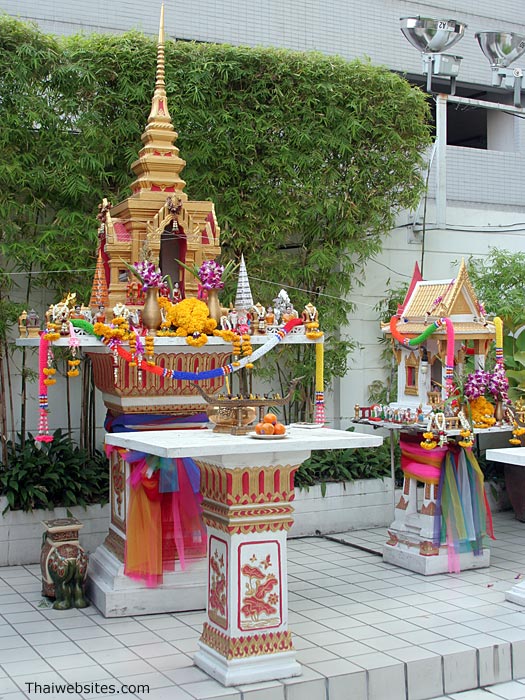
The Spirit Houses at Sino-Thai Tower, Asoke Road. To the left, the San Phra Phum (not topped with a typical prang here), to the right the San Jao Thi.
The system of beliefs of Thai people is a complicated one, and we would challenge any foreigner to be able to fully understand it. Thais do have a spiritual (and often superstitious) inclination that makes them respect more than just the teachings of the Buddha. Passing any religious shrine (also when travelling by bus), you will see Thais wai, as a sign of respect.
Animism and Hinduism are represented also in the ubiquitous Thai Spirit Houses. Spirit Houses can be seen closeby most houses, apartment buildings and office buildings (and Buddhist temples!).
Spirit Houses seen around Bangkok's streets come in two main varieties. [Larger structures may better be referred to as 'shrines'. See Hindu Shrines in Bangkok]
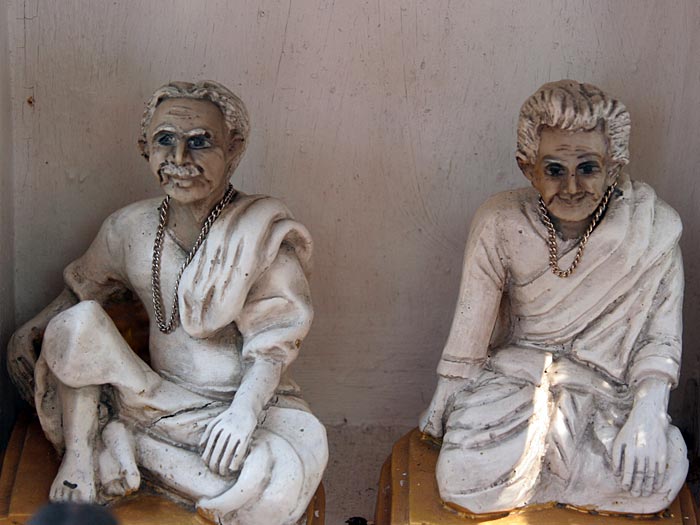
The Lords of the Land, are represented by figurines of an old man and an old woman. They inhabit the San Jao Thi. Here pictured at the San Jao Thi at Sino-Thai tower. Picture taken around 2010, checked in 2020, they are still there.
One variety (probably originating earlier) is the San Jao Thi (San Chao Thi) or Abode of the Land Lord. It resembles an old wooden Thai house, raised above ground level by usually 4 pillars. The Lords of the Land will be represented by figurines of an old man and woman. As with the other type of Spirit House, the San Phra Phum, there will be a variety of attendants, angels, offerings, dancing girls, elephants etc. around, to provide an enticing environment for the Land Lords. The relationship with the Land Lords in mutually beneficial : we look after you (by giving you a nice house), and you will look after us.
The San Phra Phum (in English, the Abode of the Land Guardian Angel, but the Thai meaning is very similar to the meaning of San Jao Thi), when adjacent to the San Jao Thi, is usually positioned higher. It stands on a single thick pillar (rather a pedestal).
San Phra Phum almost invariably will be topped by a Khmer style Prang. This building structure, common since the Khmer Empire, and in modified forms throughout the Sukhothai and Ayutthaya era, resembles a corncob. It represents Mount Meru, a sacred mountain in Hindu mythology. [on mural paintings in Buddhist Thai Temples, Mount Meru is also regularly depicted]
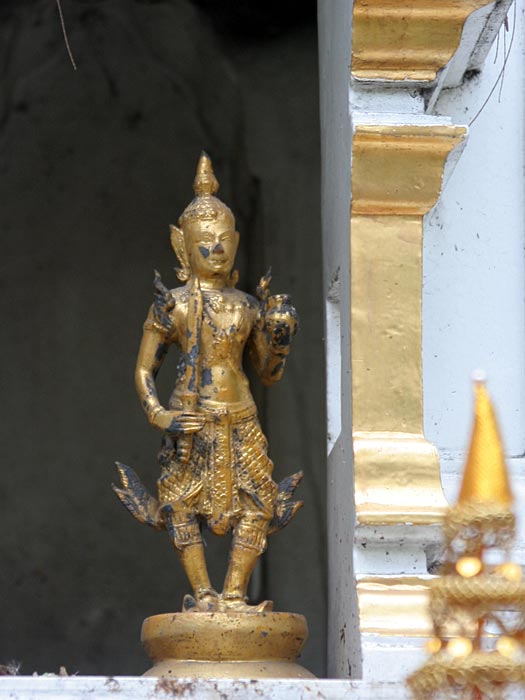
Phra Chai Mongkol (height about 15 cm) inside the 'door' of the San Phra Phum at SrinakharinWirot University compound in soi 23, Sukhumvit Road. The right hand holds a sword, the left hand carries a bag of money.
Inside the San Phra Phum, you will usually see an image of Phra Chai Mongkol, an angel like figurine, often gilded, and holding a sword in one hand, a money bag in the other hand. Phra Chai Mongkol's origin lies in Hinduism. Suffice it to say, that she is there to protect the land and its inhabitants.
The Thai Spirit House in front of most houses and buildings, is well attended to. It is common to see office girls pray in front of the Spirit House, make some small offerings of foods and drinks, and make sure that the Spirit House is well kept. What prayers are offered? Well, often prayers are directed to the Lord Buddha, which ads something more to the puzzle of Thai spirituality.
Buying and installing a Thai Spirit House is not a simple affair. Often a new Spirit House will be commissioned and installed before or at the start of building. A suitable place has to be found. The Spirit House should not stand in the shade of the building (quite difficult in Bangkok, for sure). A tree nearby is a good thing. The color of the Spirit House is also not random, and should be related to the color associated with the birthday of the owner of the property. If done properly, Hindu priests (but not Buddhist Monks) are involved in finding the right spot. An elaborate ceremony with invocations of the Gods and Mother Earth will be organized, when installing the Spirit House.
When a new owner occupies a building, a new Spirit House will often be installed, with the old one staying in place (or removed with a proper ceremony). There are some so-called Spirit House Graveyards in Thailand, where Spirit Houses that are not anymore in use, are gathered.
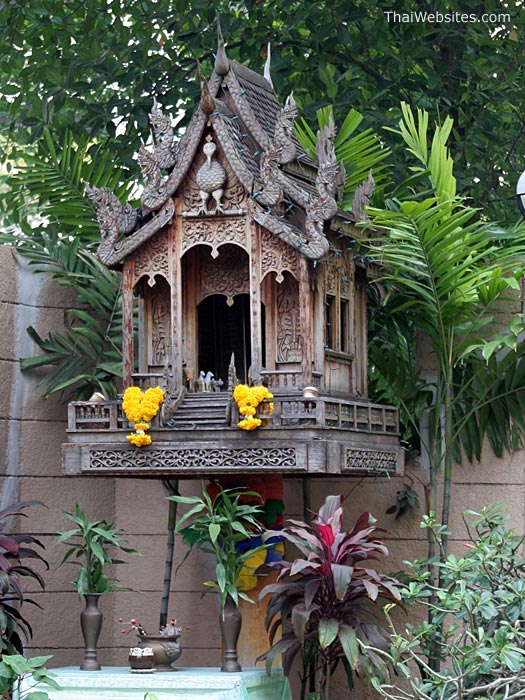
Beautiful wooden San Jao Thi, in front of an old condominium in Soi 23, Sukhumvit Road.
The images of Spirit Houses seen on this (and next) page were not taken during an elaborate field trip. We just walked around our soi on Sukhumvit Road, and took some pictures.
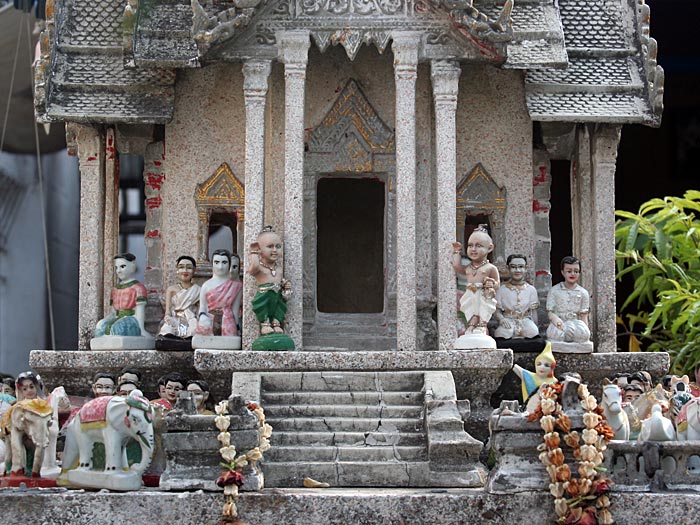
Lots of figurines can be seen in Thai Spirit Houses. They are good company for the Lords of the Land. This collection was seen at a car repair shop.
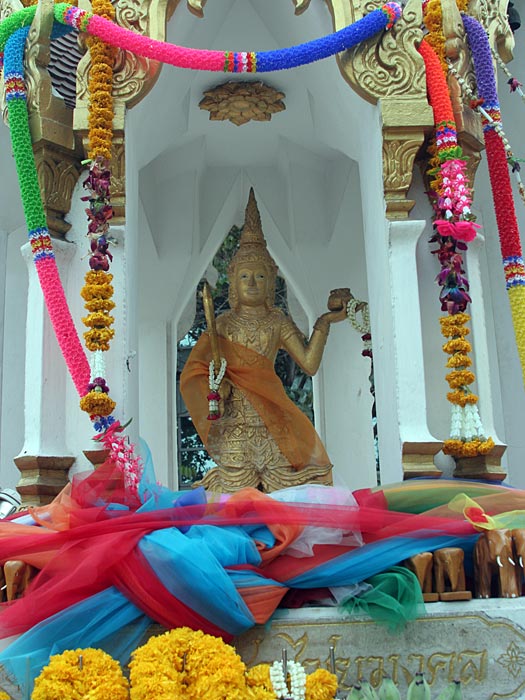
Once you know something, you can look for it. Just accidentally two days after creating this page, we walked past Dusit Thani Hotel at the beginning of Silom Road. There we found probably the largest shrine dedicated to Phra Chai Mongkol in Bangkok. At the bottom, you can see the end of an inscription. saying Mongkol. Of course, as of 2020, the old hotel is being demolished. We are quite sure the shrine is all covered up and will still be there when the new hotel has been constructed.

